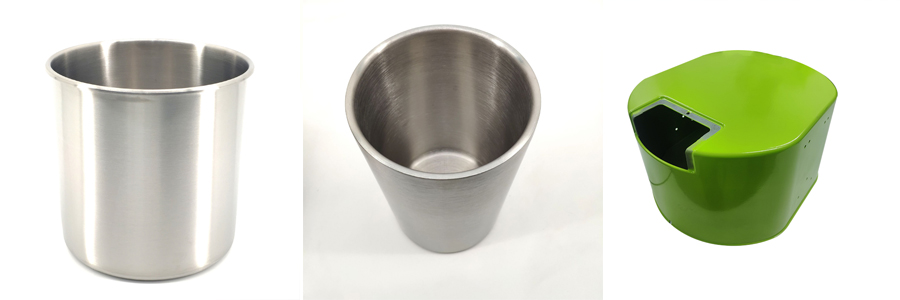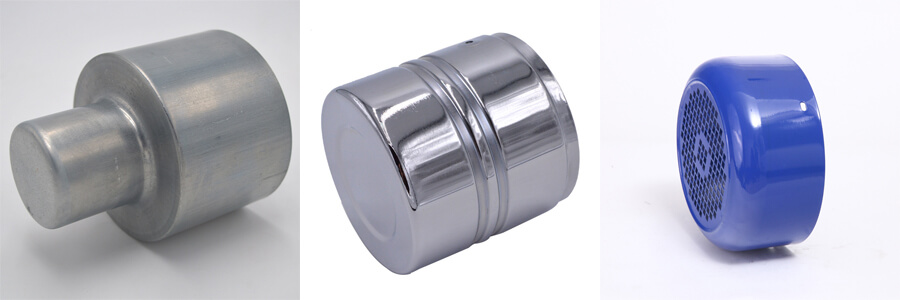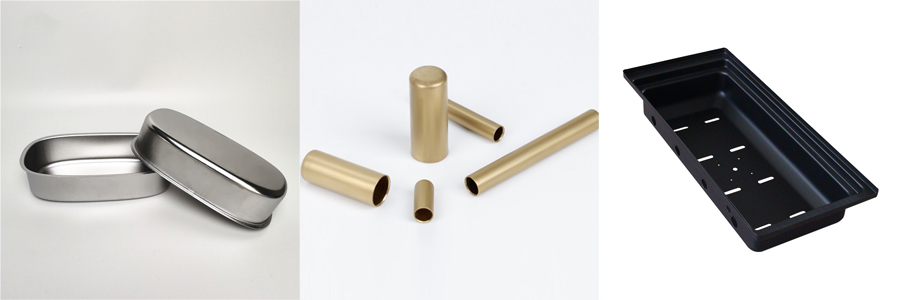Deep Drawing is a sheet metal forming process. Place the metal plate into the mold and shape it with a punch. When the depth of the part to be formed is greater than its diameter (at least twice its diameter), this process is called "deep" stretching. When the depth of the part to be formed is less than 0.3 in diameter, this process is called "shallow" stretching.


Place a flat metal plate on the positioning ring of the mold. The punch presses the metal sheet into the mold, forming a shape similar to that of the mold. The stretching tools (molds, punches, etc.) on the punching machine will generate the load or energy required to press the material during the stamping process.
During the deep drawing process, the material is transformed into the shape of the mold. This type of forming is controlled by the pressure applied to the workpiece and the lubricant (deep drawing oil) applied to the workpiece or mold.
Each stamping operation is a separate step that reduces the diameter of the part and increases its height. It may require one or more punches to produce the desired final shape. To determine the quantity of stamped parts, it must depend on the following factors: material type, material thickness, corner and bottom radius, and product shape.


Not all metals are suitable for deep drawing. Metals with high ductility are often preferred. Below is a short summary of the most frequently-used material for deep drawing.
| Material | Grade | Description |
| Low carbon steel material grade | DC04 /08F | DC04 is a low-carbon cold-rolled steel plate suitable for deep drawing processing and commonly used in the manufacturing of automotive parts, fuel tanks, and other products. |
| ST14 | ST14 is a low-carbon rolled steel plate with excellent plasticity and deep tensile properties, which is widely used in the manufacturing of electrical appliances, automotive structural components, and other fields. | |
| Stainless steel material grade | SUS304 | SUS304 is an 18-8 series stainless steel with good corrosion resistance, weldability, and deep tensile properties, widely used in the manufacturing of pressure vessels, chemical equipment, and so on. |
| SUS316L | SUS316L is a low-carbon, high nickel, and low-carbon steel with excellent corrosion resistance and good adaptability to high temperature and high pressure. It is widely used in the manufacturing of medical devices, aircraft, and other fields. | |
| Aluminum alloy material grade | 3003 | 3003 aluminum alloy has good deep tensile properties and plasticity, and is widely used in the automotive and home appliance manufacturing industry. |
| 5052 | 5052 aluminum alloy has good deep tensile properties and strength, and is suitable for manufacturing products that require high strength and toughness, such as shells, bodies, and tanks. | |
| Other material grades | SPCC | SPCC is a cold-rolled steel plate with good deep tensile properties, which is widely used in the manufacturing of automotive, electrical and other products. |
| SAPH440 | SAPH440 is a high-strength hot-rolled automotive plate suitable for manufacturing automotive components, doors, roofs, and other products. |
Overall, different material grades have their own advantages and applicability in deep drawing processing. Choosing appropriate materials and grades is crucial for ensuring product performance and quality.


As experts in deep drawing technology, we have been providing deep drawing shell services for the automotive industry, air conditioning, medical, household appliances, refrigeration systems, electronic products in countries and regions such as North America, Europe, the Middle East, and Asia.

Shanghai Yixing Technology provides professional sheet metal fabrication services. At present, the main equipment includes professional equipment such as 100-1000ton hydraulic presses, 46-630 ton stamping machines, large precision CNC machine tools, CNC lathes, etc.

Our deep drawing service is not limited to simple or standard shapes. Our craftsmanship allows for the creation of complex and intricate designs that may be challenging or even impossible to achieve using other methods. Whether your goal is cylindrical, conical, rectangular, or any other unique shape, deep drawing and stamping technology in Shanghai Yixing can meet your needs.

1. Seamless
Deep drawing can produce a uniform and seamless shape, reducing potential weaknesses in the finished product but also make it more aesthetic to some degree.
2. Strength
The material is hardened during deformation which can improve the strength of final parts.
3. Consistency
Deep drawn parts have a high degree of consistency from the beginning to the end of production.
4. Fast cycle time
The press set for deep drawing can cycle quickly, which is a very effective way to produce large quantities of parts.
5. Reduce labor cost
Deep drawing can achieve automation, significantly reducing labor costs.
6. Faster assembly
Deep drawing can create closed end shapes, eliminating the secondary process like welding etc.
Factors affecting the deep drawing depth of sheet metal parts.
1) Materials
The stretching depth of different materials may vary. For example, under the same conditions, the tensile depth of aluminum alloy is greater than that of ordinary steel plate, because aluminum alloy has better ductility and can better resist stress.
2) Thickness
The thickness directly affects the stretching depth of sheet metal parts. Generally speaking, the thinner the material, the greater the tensile depth. This is because thin plate materials are more susceptible to the influence of strain.
3) Shape
The shape of sheet metal parts also affects the stretching depth. Components with too small radii or too many sharp angles will increase strain.
4) Deep drawing speed
The faster the stretching speed, the greater the cutting force, resulting in a greater stretching depth.
In summary, the control of stretching depth is a crucial aspect in the manufacturing process of sheet metal parts. Only through rigorous manufacturing processes and preliminary design can products meet standards and achieve expected results.
The wrinkles of deep drawing parts are mainly concentrated on the wall or diameter of the product. If the mold and materials are optimized for design, wrinkling problems can be predicted and solved.
1. Reasonable design of Blank Holder structure will help the punch better resist the material yield strength and promote the material forming.
2. Optimize the punch and cavity of the stamping die to ensure suitable R angle in order to help the material move smoothly into the cavity.
3. Optimize the position of the binder structure to prevent the material from moving faster and forming wrinkles.
4. Optimize the shape of the blank material so that material can move uniformly into the cavity to reduce wall unevenness, cracks or wrinkles.
5. Reduce wrinkles and cracks caused by uneven friction between the material and the mold by adding lubricating oil or plastic film.
6. To do surface treatment like brushing, polishing etc to increase aesthetics.